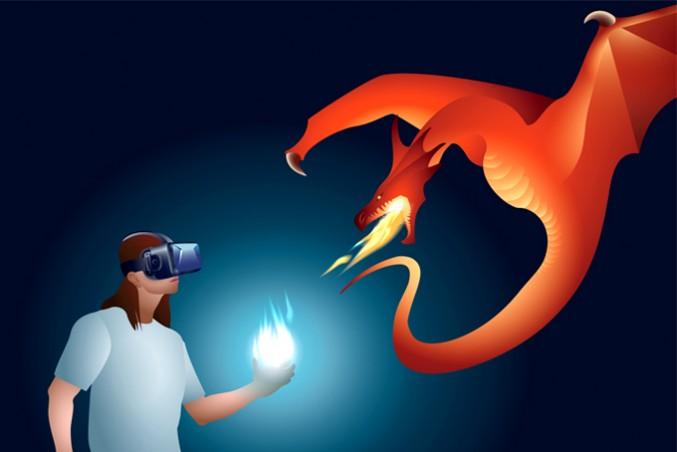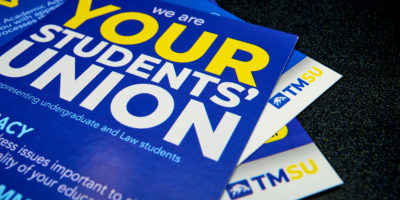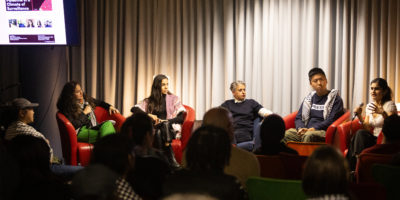It’s been heralded as the device that will reshape the world of game design and multimedia storytelling. Alfea Donato took a look into the latest virtual reality headset — Oculus Rift — and the young developers that are paving the way for its release
You’re covered in blood. Pink walls trap you in a tight dark tunnel, forcing you to move forward. You tilt your head back and watch huge red blood cells whizzing above, coming dangerously close to hitting you – except you’re not really there.
Visually, you’re exploring the veins of the human body. In reality, you’re standing on Ryerson’s campus with a pair of thick black goggles strapped to your face.
This virtual field trip is made possible by Vessels VR, the thesis project of fourth-year radio and television arts (RTA) student Josh Maldonado. It’s an experience impossible without the Oculus Rift, a headset leading the rise of virtual reality (VR) technology, a field using advanced computer-generated simulations of 3D environments. While being heralded as single-handedly transforming the video game industry, the Rift’s potential to immerse users more intimately than any media has made it a storytelling platform like no other.
For a device capable of simulating reality, the Rift comes from humble beginnings. The Oculus Rift was invented by Palmer Luckey, a homeschooled teenager tinkering in his parents’ garage. Frustrated with the clunky low quality devices offered by virtual reality companies for thousands of dollars, Luckey sought to engineer a headset cheap enough for mainstream consumers and better than anything else on the market. He succeeded — his Oculus VR Kickstarter campaign’s goal of $250,000 was reached nearly 10 times over, and ended with $2.4 million pledged to the project in 2012.
Since then, Oculus has revived life-like virtual reality from a possibility only in cyberpunk fiction to an affordable and attainable medium. Although the consumer version has not been released, Oculus Rift development kits (DK) allow anyone to develop their own video games and applications. There are currently two models, the DK1 and more recent DK2, which retails online at $350. It was in a Kensington Market bar — Handlebar — with Toronto’s VR meetup group that Maldonado first encountered the Rift.
In real life, he was sitting in a dimly lit room in Handlebar, surrounded by chatty drunks and Rift developers. As soon as he wore the Rift, all of Toronto faded away.
He was alone, pacing inside a futuristic bachelor apartment, watching ominous helicopters hover in the cloudy night sky. The game Technolust, by Canadian company Iris VR, had thrown Maldonado into a Blade Runner-inspired adventure of overthrowing Big Brotheresque corporations and neon-lit nightlife.
“There’s all this noise going on around you in the bar. Then you try this thing on and it does something to your senses that nothing has done before,” Maldonado said.
“There’s all this noise going on around you in the bar. Then you try this thing on and it does something to your senses that nothing has done before.”
The idea for Vessels came to Maldonado two weeks before his thesis project pitch was due.
“I used to be a big Magic School Bus fan,” Maldonado said. “They’d take all these wicked and unbelievable field trips … that you can’t take and virtual reality allows you to go places you can’t go.”
The idea behind virtual field trips was what got Facebook’s attention, which bought the Oculus VR company for $2 billion in March.
“Imagine enjoying a court side seat at a game, studying in a classroom of students and teachers all over the world or consulting with a doctor face-to-face – just by putting on goggles in your home,” wrote Facebook CEO Mark Zuckerberg in a Facebook post announcing the acquisition.
Maldonado was able to put on his own goggles at home by buying an early version of the Rift a day before his pitch.
“I bought the DK1 off of some stoner somewhere in the boonies of northern Ontario,” Maldonado said. “I couldn’t afford the DK2 just yet.” Pitching was a moment Maldonado says he’ll remember for the rest of his life.
Usually, fourth-year RTA students pitch thesis projects to their professors as teams of several people, and most of their projects involve established mediums like television or film.
Maldonado couldn’t have been more different – he stood before them alone and with a device some had never seen before.
“I thought they were going to trash it, but I get up there and I give my five minute spiel. This may just be me idealizing but I got the longest, [biggest] applause,” Maldonado said.
“Afterwards, everybody was like, ‘Yo I want to be on your team if my project doesn’t get picked.'” Students weren’t the only ones excited. Two days after Vessels’ team came together, Faculty of Communications and Design media lead Jeremy Littler approached them and said,
“I’ve got a DK2 for you.”
“He doesn’t know me and he doesn’t know who we are, but as soon as he hears there’s a student project that involves virtual reality, he gets Ryerson to purchase the DK2 for us,” Maldonado said.
Throwing fireballs is harder than it looks. Standing on a stone column, you aim your fist at your red-robed opponent and hurl blazing bursts of flame at him. He teleports from column to column, while below your combat, cherry blossom petals and tree leaves flicker in the wind, flying across the grassy landscape. With the exception of being able to see a white, skeletal, animated outline of your real hands, you’d think you were actually having a magical battle to the death.
At the Toronto Audio Video Entertainment Show (TAVES) on Nov. 1, developers and curious onlookers gathered for Toronto VR’s Oculus Rift conference and played this demonstration, along with other Rift experiences. One man spoke rapidly into a microphone and played random notes on a keyboard, his sounds translating to psychedelic colours like echolocation in his goggles. His cacophony of constant sounds was punctured by the yelps beside him, from Rift users watching a recreation of The Matrix, streams of bright green code falling right on top of them.
Stephan Tanguay, creator of the fireball demonstration and organizer of the Toronto VR meetup group Maldonado joined, said his group went from 50 to 300 members within a few months. They still meet inside Handlebar, despite the growth.
“Every time you go, you see a new version of a pal’s work. Seeing that progression and getting that feedback is really helpful,” Tanguay said.
While many Rift developers focus on video games, Brian Peiris, web developer and a fellow Toronto VR member, takes a more educational route with RiftSketch, an app that livecodes objects as you write Javascript. Using a modified webcam to see his keyboard in real life, Peiris can type while wearing the Rift and watch objects change colour or move with just a few lines of code.
“It’s really engaging to be able to see your creation immediately,” Peiris said. “I think for someone learning code, it would be very informative.” Universities in the U.S. are already looking into using the Oculus Rift in classrooms.
“It’s really engaging to be able to see your creation immediately.”
YouVisit, a company that provides virtual tours, uses the Oculus Rift to take users on walks through campuses. It’s a feat of instant teleportation that’s garnered over 240,000 hits for Yale University’s virtual tour; the success has caused the school to look into using the Rift for outreach to international and prospective students. Oculus itself is also encouraging student involvement. CEO Brendan Iribe donated $31 million to the University of Maryland in September to fund a new computer science building with a virtual reality lab.
However, the Rift isn’t the only new VR headset on the block. Sony is currently developing Project Morpheus, but unlike the Rift, will only release a consumer version that will likely be just for the PlayStation 4 and restricted to Sony-approved development. Samsung partnered with Oculus to develop the Gear VR, a wireless headset focused on entertainment, but it’s only compatible with Samsung’s Galaxy Note 4 smartphone. Neither have been as open-source and independent developer-friendly as the Rift, which Maldonado said is its greatest strength.
“The coolest thing is that Oculus is trying to share [the Rift] at the [lowest] price point possible, so developers like us can take it and make creative things with it,” Maldonado said. “They’re not trying to hide it for themselves and keep all the money, they easily could have done that.” Tanya Kan is a Rift developer who worked on the game Double Blind, a multiplayer game of tag between Medusa and some unfortunate humans, taking place in ancient Greek ruins.
She says the VR arms race will only result in survival of the realest.
“I’m happy to see VR having multiple players, as that would only influence not only better VR hardware, but better … graphic cards and game integration,” Kan said. However, Kan adds that Oculus feels more like a developer-first company and has fixed bugs based on feedback.
Over 100,000 Rift development kits have shipped and the newest unreleased prototype, Crescent Bay, promises to be even more of an improvement because of developers’ criticism of the DK1 and DK2.
For Peiris, he’s hopeful for a future where everyone works in VR offices and he can code inside the Rift every day.
“Assuming VR takes off like the enthusiasts expect it to, it could change a lot of things. It’s not limited to gaming or entertainment,” Peiris said. “That’s not even to mention the concept of VR worlds, doing social things in VR. It’s some sort of Pandora’s box, in that sense.”
However, the immersion isn’t without its weaknesses.
“The moment you start developing for Oculus and 3D, and especially if you want art assets with some realism involved, it likely would require a lot of infrastructure and investment of time, money and talent to get it out to market,” Kan said.
“The moment you start developing for Oculus and 3D, and especially if you want art assets with some realism involved, it likely would require a lot of infrastructure and investment of time, money and talent to get it out to market.”
Thanks to being incubated in Ryerson’s Transmedia Zone, some of those issues aren’t impacting Vessels as much as they would, but Maldonado has noticed a challenge in finding PCs with enough power to handle the Rift.
“The computers are not the best type for graphic rendering that’s going to be required of virtual reality development,” Maldonado said. “Everything’s been really laggy and takes a long time to render.”
Programming-wise, lagging can be annoying, but within the Oculus this can be literally sickening. Lagging in the Rift has been known to cause nausea in some cases, especially in applications involving a lot of movement. Simulation sickness has been an ongoing problem for users and developers, a disadvantage for a medium meant to immerse as much as possible. So far, Vessels is in its early stages. Exploration through the first vein is done, with plans made for users to also go through the arteries, the heart and throat tissues.
Ideally, Maldonado wants to make more virtual field trips and make money from his work. Since the Transmedia Zone doesn’t fund Vessels, a Kickstarter fund for the project will be held in the future.
“I’d like to continue developing these experiences … imagine taking a field trip to ancient Egypt or the rainforest,” Maldonado said. “I want to be able to walk away and say I really did challenge the standards of content development.”
It’s safe to say creating an experience where you swim in bloodstreams is more than challenging standards – it’s pioneering standards of its own, in a field where Maldonado and other developers are dictating what this new media will become for consumers. They’re shaping entire worlds only a headset away.











Matthew O'Farrell
I’m looking to get in touch with Josh Maldonado – can anyone help me with contact information ?
Brave new worlds | The Eyeopener
Excellent article. Keep writing such kind of info on your
page. Im really impressed by your site.
Hey there, You have done a great job. I’ll definitely digg it and individually recommend
to my friends. I am sure they’ll be benefited from this web site.